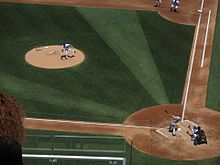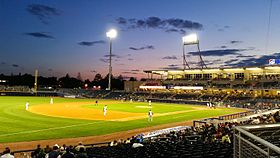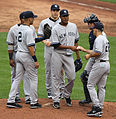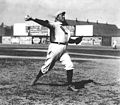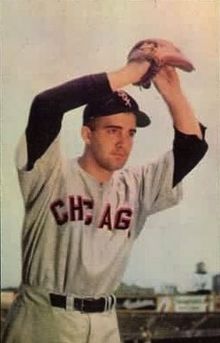Portal:Baseball
Portal maintenance status: (June 2018)
|
| Main page | Content, Categories & Topics | WikiProjects & Things you can do |
The Baseball Portal
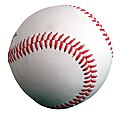
Baseball is a bat-and-ball sport played between two teams of nine players each, taking turns batting and fielding. The game occurs over the course of several plays, with each play generally beginning when a player on the fielding team, called the pitcher, throws a ball that a player on the batting team, called the batter, tries to hit with a bat. The objective of the offensive team (batting team) is to hit the ball into the field of play, away from the other team's players, allowing its players to run the bases, having them advance counter-clockwise around four bases to score what are called "runs". The objective of the defensive team (referred to as the fielding team) is to prevent batters from becoming runners, and to prevent runners advancing around the bases. A run is scored when a runner legally advances around the bases in order and touches home plate (the place where the player started as a batter).
The opposing teams switch back and forth between batting and fielding; the batting team's turn to bat is over once the fielding team records three outs. One turn batting for each team constitutes an inning. A game is usually composed of nine innings, and the team with the greater number of runs at the end of the game wins. Most games end after the ninth inning, but if scores are tied at that point, extra innings are usually played. Baseball has no game clock, though some competitions feature pace-of-play regulations such as the pitch clock to shorten game time.
Baseball evolved from older bat-and-ball games already being played in England by the mid-18th century. This game was brought by immigrants to North America, where the modern version developed. Baseball's American origins, as well as its reputation as a source of escapism during troubled points in American history such as the American Civil War and the Great Depression, have led the sport to receive the moniker of "America's Pastime"; since the late 19th century, it has been unofficially recognized as the national sport of the United States, though in modern times is considered less popular than other sports, such as American football. In addition to North America, baseball spread throughout the rest of the Americas and the Asia–Pacific in the 19th and 20th centuries, and is now considered the most popular sport in parts of Central and South America, the Caribbean, and East Asia, particularly in Japan, South Korea, and Taiwan. (Full article...)
 Featured articles - load new batch
Featured articles - load new batch
-
Image 1
Derek Sanderson Jeter (/ˈdʒiːtər/ JEE-tər; born June 26, 1974), nicknamed "the Captain", is an American former professional baseball shortstop, businessman, and baseball executive. As a player, Jeter spent his entire 20-year Major League Baseball (MLB) career with the New York Yankees. He was elected to the Baseball Hall of Fame in his first year of eligibility in 2020; he received 396 of 397 possible votes, the second-highest percentage in MLB history (behind only teammate Mariano Rivera) and the highest by a position player. He was the chief executive officer (CEO) and part owner of the league's Miami Marlins from September 2017 to February 2022.
A five-time World Series champion with the Yankees, Jeter is regarded as a central contributor to the franchise's dynasty during the late 1990s and early 2000s for his hitting, base-running, fielding, and leadership. He is the Yankees' all-time career leader in hits (3,465), doubles (544), games played (2,747), stolen bases (358), times on base (4,716), plate appearances (12,602) and at bats (11,195). His accolades include 14 All-Star selections, five Gold Glove Awards, five Silver Slugger Awards, two Hank Aaron Awards, and a 2009 Roberto Clemente Award. Jeter was the 28th player to reach 3,000 hits and finished his career ranked sixth in MLB history in career hits and first among shortstops. In 2017, the Yankees retired his uniform number 2. (Full article...) -
Image 2The 2009 World Series was the championship series of Major League Baseball's (MLB) 2009 season. As the 105th edition of the World Series, it was a best-of-seven playoff contested between the Philadelphia Phillies, champions of the National League (NL) and defending World Series champions, and the New York Yankees, champions of the American League (AL). The Yankees defeated the Phillies, 4 games to 2, winning their 27th World Series championship.
The series was played between October 28 and November 4, broadcast on Fox, and watched by an average of roughly 19 million viewers. Home field advantage for the Series went to the AL for the eighth straight year as a result of its 4–3 win in the All-Star Game. The Phillies earned their berth into the playoffs by winning the National League East. The Yankees won the American League East to earn their berth, posting the best record in the Major Leagues. The Phillies reached the World Series by defeating the Colorado Rockies in the best-of-five National League Division Series and the Los Angeles Dodgers in the best-of-seven NL Championship Series (NLCS). The Yankees defeated the Minnesota Twins in the American League Division Series and the Los Angeles Angels of Anaheim in the AL Championship Series (ALCS) to advance to their first World Series since 2003. As a result of their loss, the Phillies became the first team since the 2001 Yankees to lose the World Series after winning it the previous year. As of 2024, this is the most recent World Series to feature a defending champion. (Full article...) -
Image 3
Michael Jeffrey Jordan (born February 17, 1963), also known by his initials MJ, is an American businessman and former professional basketball player. He played 15 seasons in the National Basketball Association (NBA) between 1984 and 2003, winning six NBA championships with the Chicago Bulls. He was integral in popularizing basketball and the NBA around the world in the 1980s and 1990s, becoming a global cultural icon. His profile on the NBA website states, "By acclamation, Michael Jordan is the greatest basketball player of all time."
Jordan played college basketball with the North Carolina Tar Heels. As a freshman, he was a member of the Tar Heels' national championship team in 1982. Jordan joined the Bulls in 1984 as the third overall draft pick and quickly emerged as a league star, entertaining crowds with his prolific scoring while gaining a reputation as one of the best defensive players. His leaping ability, demonstrated by performing slam dunks from the free-throw line in Slam Dunk Contests, earned him the nicknames "Air Jordan" and "His Airness". Jordan won his first NBA title with the Bulls in 1991 and followed that achievement with titles in 1992 and 1993, securing a three-peat. Citing physical and mental exhaustion from basketball and superstardom, Jordan abruptly retired from basketball before the 1993–94 NBA season to play Minor League Baseball in the Chicago White Sox organization. He returned to the Bulls in March 1995 and led them to three more championships in 1996, 1997, and 1998, as well as a then-record 72 regular season wins in the 1995–96 NBA season. Jordan retired for the second time in January 1999, returning for two more NBA seasons from 2001 to 2003 as a member of the Washington Wizards. He was selected to play for the United States national team during his college and NBA careers, winning four gold medals—at the 1983 Pan American Games, 1984 Summer Olympics, 1992 Tournament of the Americas and 1992 Summer Olympics—while also being undefeated. (Full article...) -
Image 4
Arthur Joseph Houtteman (August 7, 1927 – May 6, 2003) was an American right-handed pitcher in Major League Baseball who played for 12 seasons in the American League with the Detroit Tigers, Cleveland Indians and Baltimore Orioles. In 325 career games, Houtteman pitched 1,555 innings and posted a win–loss record of 87–91, with 78 complete games, 14 shutouts, and a 4.14 earned run average (ERA).
Known on the sandlot for his pitching motion, Houtteman was signed by scout Wish Egan in 1945 at 17 years of age. He was recruited by major league teams, and joined a Tigers pitching staff that had lost players to injuries and World War II. After moving between the major and minor leagues over the next few years, he was nearly killed in an automobile accident just before the 1949 season. Houtteman rebounded from his injuries and went on to win 15 games that season and made his only All-Star appearance in the following year. (Full article...) -
Image 5
First Horizon Park, formerly known as First Tennessee Park, is a baseball park in downtown Nashville, Tennessee, United States. The home of the Triple-A Nashville Sounds of the International League, it opened on April 17, 2015, and can seat up to 10,000 people. It replaced the Sounds' former home, Herschel Greer Stadium, where the team played from its founding in 1978 through 2014.
The park was built on the site of the former Sulphur Dell, a minor league ballpark in use from 1885 to 1963. It is located between Third and Fifth Avenues on the east and west (home plate, the pitcher's mound, and second base are directly in line with Fourth Avenue to the stadium's north and south) and between Junior Gilliam Way and Harrison Street on the north and south. The Nashville skyline can be seen from the stadium to the south. (Full article...) -
Image 6
Riders Field, formerly known as Dr Pepper/Seven Up Ballpark and Dr Pepper Ballpark, is a baseball park in Frisco, Texas, United States. The home of the Double-A Frisco RoughRiders of the Texas League, it opened on April 3, 2003, and can seat up to 10,216 people. Though primarily a venue for Minor League Baseball games, the facility also hosts high school and college baseball tournaments, and other public and private events throughout the year. It has been the site of three Texas League All-Star Games.
Since its opening, Riders Field has won awards and garnered praise for its unique design, feel, and numerous amenities. In his design, park architect David M. Schwarz desired the creation of a village-like "park within a (ball)park". The stadium received the 2003 Texas Construction Award for Best Architectural Design. (Full article...) -
Image 7
A picture of a Wii Sports disc
Wii Sports is a 2006 sports simulation video game developed and published by Nintendo for the Wii video game console. The game was released in North America along with the Wii on November 19, 2006, and in Japan, Australia, and Europe the following month. It was included as a pack-in game with the console in all territories except Japan, making it the first sports game included with the launch of a Nintendo system since Mario's Tennis for the Virtual Boy in 1995. The game was later released on its own as part of the Nintendo Selects collection of games.
Wii Sports is a collection of five sports simulations designed to demonstrate the motion-sensing capabilities of the Wii Remote. The five sports included are tennis, baseball, bowling, golf, and boxing. Players use the Wii Remote to mimic actions performed in real-life sports, such as swinging a tennis racket or rolling a bowling ball. The rules for each game are simplified to make them more accessible to new players. The game also features training and fitness modes that monitor players' progress in the sports. (Full article...) -
Image 8Disco Demolition Night was a Major League Baseball (MLB) promotion on Thursday, July 12, 1979, at Comiskey Park in Chicago, Illinois, that ended in a riot. At the climax of the event, a crate filled with disco records was blown up on the field between games of the twi-night doubleheader between the Chicago White Sox and the Detroit Tigers. Many had come to see the explosion rather than the games and rushed onto the field after the detonation. The playing field was so damaged by the explosion and by the rioters that the White Sox were required to forfeit the second game to the Tigers.
In the late 1970s, dance-oriented disco was the most popular music genre in the United States, particularly after being featured in hit films such as Saturday Night Fever (1977). However, disco sparked a major backlash from rock music fans—an opposition prominent enough that the White Sox, seeking to fill seats at Comiskey Park during a lackluster season, engaged Chicago shock jock and anti-disco campaigner Steve Dahl for the promotion at the July 12 doubleheader. Dahl's sponsoring radio station was WLUP (97.9 FM, now WCKL), so admission was discounted to 98 cents for attendees who turned in a disco record; between games, Dahl was to destroy the collected vinyl in an explosion. (Full article...) -
Image 9
Morris Berg (March 2, 1902 – May 29, 1972) was an American professional baseball catcher and coach in Major League Baseball who later served as a spy for the Office of Strategic Services during World War II. He played 15 seasons in the major leagues, almost entirely for four American League teams, though he was never more than an average player and was better known for being "the brainiest guy in baseball." Casey Stengel once described Berg as "the strangest man ever to play baseball."
Berg was a graduate of Princeton University and Columbia Law School, spoke several languages, and regularly read ten newspapers a day. His reputation as an intellectual was fueled by his successful appearances as a contestant on the radio quiz show Information Please, in which he answered questions about the etymology of words and names from Greek and Latin, historical events in Europe and the Far East, and ongoing international conferences. (Full article...) -
Image 10
Tyler Wayne Skaggs (July 13, 1991 – July 1, 2019) was an American left-handed professional baseball starting pitcher who played in Major League Baseball (MLB) for the Arizona Diamondbacks and Los Angeles Angels from 2012 until his death in 2019.
A native of Woodland Hills, California, and a graduate of Santa Monica High School, Skaggs was a supplemental first-round selection for the Angels in the 2009 Major League Baseball draft. He was traded to the Diamondbacks the following year as part of an exchange for pitcher Dan Haren and rose through Arizona's farm system. After two consecutive appearances at the All-Star Futures Game in 2011 and 2012, Skaggs made his major league debut on August 22, 2012, against the Miami Marlins. He remained with the Diamondbacks through the end of the season, but was optioned to the minor leagues in 2013. (Full article...) -
Image 11
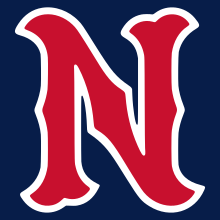
The Nashville Sounds are a Minor League Baseball team of the International League and the Triple-A affiliate of the Milwaukee Brewers. They are located in Nashville, Tennessee, and are named for the city's association with the music industry, specifically the "Nashville sound", a subgenre of country music which originated in the city in the mid-1950s. The team plays their home games at First Horizon Park, which opened in 2015 on the site of the historic Sulphur Dell ballpark. The Sounds previously played at Herschel Greer Stadium from its opening in 1978 until the end of the 2014 season. They are the oldest active professional sports franchise in Nashville.
Established as an expansion team of the Double-A Southern League in 1978, the Sounds led all of Minor League Baseball in attendance in their inaugural season and continued to draw the Southern League's largest crowds in each of their seven years as members. On the field, the team won six consecutive second-half division titles from 1979 to 1984 and won the Southern League championship twice: in 1979 as the Double-A affiliate of the Cincinnati Reds and again in 1982 as the Double-A affiliate of the New York Yankees. (Full article...) -
Image 12

Hershiser pitching for the Dodgers in 1993
During the 1988 Major League Baseball season, pitcher Orel Hershiser of the Los Angeles Dodgers set the MLB record for consecutive scoreless innings pitched. Over 59 consecutive innings, opposing hitters did not score a run against Hershiser. During the streak, he averted numerous high-risk scoring situations. The streak spanned from the sixth inning of an August 30 game against the Montreal Expos to the 10th inning of a September 28 game against the San Diego Padres. The previous record of 58+2⁄3 innings was set by former Dodger pitcher Don Drysdale in 1968; as the team's radio announcer, Drysdale called Hershiser's streak as he pursued the new record. Pundits have described the streak as among the greatest records in baseball history, with one pundit ranking it among the greatest individual feats in American sports.
During the streak, the Elias Sports Bureau changed its criteria for the official consecutive scoreless innings record for starting pitchers from including fractional innings in which one or two outs had been recorded to counting only complete scoreless innings. Since the streak was active at the end of the 1988 season, it could have spanned two separate seasons. However, Hershiser yielded a run in his first inning of work in the 1989 season against the Cincinnati Reds, thus ending the streak at 59 consecutive scoreless innings pitched. The streak includes only innings pitched in the regular season, excluding eight scoreless innings Hershiser pitched to start Game 1 of the 1988 National League Championship Series on October 4 (unofficially extending his streak to 67 combined innings). Although he completed the ninth inning in each start, the streak's final game lasted 16 innings, of which he pitched only the first 10. Thus, Hershiser did not match Drysdale's record of six consecutive complete game shutouts. Like Drysdale's streak, the penultimate game of Hershiser's streak was a Dodgers–Giants game that featured a controversial umpire's ruling that saved the streak. (Full article...) -
Image 13
Kenesaw Mountain Landis (/ˈkɛnɪsɔː ˈmaʊntɪn ˈlændɪs/; November 20, 1866 – November 25, 1944) was an American jurist who served as a United States federal judge from 1905 to 1922 and the first commissioner of baseball from 1920 until his death. He is remembered for his resolution of the Black Sox Scandal, in which he expelled eight members of the Chicago White Sox from organized baseball for conspiring to lose the 1919 World Series and repeatedly refused their reinstatement requests. His iron rule over baseball in the near quarter-century of his commissionership is generally credited with restoring public confidence in the game.
Landis was born in Millville, Ohio. Raised in Indiana, he became a lawyer, and then personal secretary to Walter Q. Gresham, the new United States Secretary of State, in 1893. He returned to private practice after Gresham died in office. (Full article...) -
Image 14
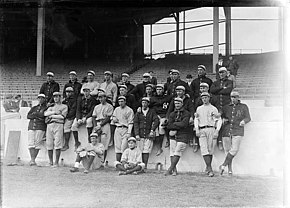
The 1913 squad, the first that went by the name "Yankees"
The history of the New York Yankees Major League Baseball (MLB) team spans more than a century. Frank J. Farrell and William Stephen Devery bought the rights to an American League (AL) club in New York City after the 1902 season. The team, which became known as the Yankees in 1913, rarely contended for the AL championship before the acquisition of outfielder Babe Ruth after the 1919 season. With Ruth in the lineup, the Yankees won their first AL title in 1921, followed by their first World Series championship in 1923. Ruth and first baseman Lou Gehrig were part of the team's Murderers' Row lineup, which led the Yankees to a then-AL record 110 wins and a Series championship in 1927 under Miller Huggins. They repeated as World Series winners in 1928, and their next title came under manager Joe McCarthy in 1932.
The Yankees won the World Series every year from 1936 to 1939 with a team that featured Gehrig and outfielder Joe DiMaggio, who recorded a record hitting streak during New York's 1941 championship season. New York set a major league record by winning five consecutive championships from 1949 to 1953, and appeared in the World Series nine times from 1955 to 1964. Mickey Mantle, Yogi Berra, and Whitey Ford were among the players fielded by the Yankees during the era. After the 1964 season, a lack of effective replacements for aging players caused the franchise to decline on the field, and the team became a money-loser for owners CBS while playing in an aging stadium. (Full article...) -
Image 15The 2004 World Series was the championship series of Major League Baseball's (MLB) 2004 season. The 100th edition of the World Series, it was a best-of-seven playoff between the American League (AL) champion Boston Red Sox and the National League (NL) champion St. Louis Cardinals; the Red Sox swept the Cardinals in four games. The series was played from October 23 to 27, 2004, at Fenway Park and Busch Memorial Stadium, broadcast on Fox, and watched by an average of just under 25.5 million viewers. The Red Sox's World Series championship was their first since 1918, ending the Curse of the Bambino.
The Cardinals earned their berth into the playoffs by winning the NL Central division title, and had the best win–loss record in the NL. The Red Sox won the AL wild card to earn theirs. The Cardinals reached the World Series by defeating the Los Angeles Dodgers in the best-of-five NL Division Series and the Houston Astros in the best-of-seven NL Championship Series. The Red Sox defeated the Anaheim Angels in the AL Division Series. After trailing three games to none to the New York Yankees in the AL Championship Series, the Red Sox came back to win the series, advancing to their first World Series since 1986. The Cardinals made their first appearance in the World Series since 1987. With the New England Patriots winning Super Bowl XXXVIII, the World Series victory made Boston the first city to have Super Bowl and World Series championship teams in the same year (2004) since Pittsburgh in 1979. The Red Sox became the third straight wild card team to win the World Series; the Anaheim Angels won in 2002 and the Florida Marlins won in 2003. (Full article...)
General images - load new batch
-
Image 1The strike zone, which determines the outcome of most pitches, varies in vertical length depending on the batter's typical height while swinging. (from Baseball rules)
-
Image 3Japanese-Americans spectating a World War II-era game while in an internment camp. America's ties to immigrants and to Japan have been deeply shaped by a shared baseball heritage. (from History of baseball)
-
Image 4Cover of Official Base Ball Rules, 1921 edition, used by the American League and National League (from Baseball rules)
-
Image 7Pick-off attempt on runner (in red) at first base (from Baseball rules)
-
Image 9Diagram indicating the standard layot of positions (from Baseball)
-
Image 10By the 1860s Civil War, baseball (bottom) had overtaken its fellow bat-and-ball sport cricket (top) in popularity within the United States. (from History of baseball)
-
Image 12An Afghan girl playing baseball in August 2002 (from Baseball)
-
Image 13A New York Yankees batter (Andruw Jones) and a Boston Red Sox catcher at Fenway Park (from Baseball)
-
Image 15Diagram of a baseball field Diamond may refer to the square area defined by the four bases or to the entire playing field. The dimensions given are for professional and professional-style games. Children often play on smaller fields. (from Baseball)
-
Image 16A batter follows through after swinging at a pitched ball. (from Baseball rules)
-
Image 17In May 2010, the Philadelphia Phillies' Roy Halladay pitched the 20th major league perfect game. That October, he pitched only the second no-hitter in MLB postseason history. (from History of baseball)
-
Image 18A pitcher handing off the ball after being taken out of the game during a mound meeting. (from Baseball)
-
Image 19A runner sliding into home plate and scoring. (from Baseball)
-
Image 20Jackie Robinson in 1945, with the era's Kansas City Royals, a barnstorming squad associated with the Negro American League's Kansas City Monarchs (from Baseball)
-
Image 21The standard fielding positions (from Baseball rules)
-
Image 22Pitchers are generally substituted during mound visits (team gatherings at the pitcher's mound). (from Baseball rules)
-
Image 231906 World Series, infielders playing "in" for the expected bunt and the possible play at the plate with the bases loaded (from Baseball rules)
-
Image 25Sadaharu Oh managing the Japan national team in the 2006 World Baseball Classic. Playing for the Central League's Yomiuri Giants (1959–80), Oh set the professional world record for home runs. (from Baseball)
-
Image 26A well-worn baseball (from Baseball)
-
Image 27The American Tobacco Company's line of baseball cards featured shortstop Honus Wagner of the Pittsburgh Pirates from 1909 to 1911. In 2007, the card shown here sold for $2.8 million. (from Baseball)
-
Image 28Baseball games sometimes end in a walk-off home run, with the batting team usually gathering at home plate to celebrate the scoring of the winning run(s). (from Baseball rules)
-
Image 29Pesäpallo, a Finnish variation of baseball, was invented by Lauri "Tahko" Pihkala in the 1920s, and after that, it has changed with the times and grown in popularity. Picture of Pesäpallo match in 1958 in Jyväskylä, Finland. (from Baseball)
-
Image 302013 World Baseball Classic championship match between the Dominican Republic and Puerto Rico, March 20, 2013 (from Baseball)
-
Image 31Fenway Park, home of the Boston Red Sox. The Green Monster is visible beyond the playing field on the left. (from Baseball)
-
Image 32Cy Young—the holder of many major league career marks, including wins and innings pitched, as well as losses—in 1908. MLB's annual awards for the best pitcher in each league are named for Young. (from Baseball)
-
Image 33The strike zone determines the result of most pitches, and varies in vertical length for each batter. (from Baseball)
-
Image 34Alexander Cartwright, father of modern baseball (from History of baseball)
-
Image 35Two players on the baseball team of Tokyo, Japan's Waseda University in 1921 (from Baseball)
-
Image 36A first baseman receives a pickoff throw, as the runner dives back to first base. (from Baseball)
-
Image 37Sadaharu Oh managing the Japan national team in the 2006 World Baseball Classic. Playing for the Central League's Yomiuri Giants (1959–80), Oh set the professional world record for home runs with 868. (from History of baseball)
-
Image 39Rickey Henderson—the major leagues' all-time leader in runs and stolen bases—stealing third base in a 1988 game (from Baseball)
-
Image 40Jackie Robinson in 1945, with the era's Kansas City Royals, a barnstorming squad associated with the Negro American League's Kansas City Monarchs (from History of baseball)
-
Image 41Baserunners generally stand a short distance away from their base between pitches, preparing themselves to either go back or steal the next base. (from Baseball rules)
-
Image 43The NL champion New York Giants baseball team, 1913. Fred Merkle, sixth in line, had committed a baserunning gaffe in a crucial 1908 game that became famous as Merkle's Boner. (from History of baseball)
-
Image 44The typical motion of a right-handed pitcher (from Baseball rules)
-
Image 45A game from the Cantigas de Santa Maria, c. 1280, involving tossing a ball, hitting it with a stick and competing with others to catch it (from History of baseball)
 Good articles - load new batch
Good articles - load new batch
-
Image 1
Charles Herbert "Red" Ruffing (May 3, 1905 – February 17, 1986) was an American professional baseball player. A pitcher, he played in Major League Baseball (MLB) from 1924 through 1947. He played for the Boston Red Sox, New York Yankees, and Chicago White Sox. Ruffing is most remembered for his time with the highly successful Yankees teams of the 1930s and 1940s.
Ruffing dropped out of school as a child to work in a coal mine in his native Illinois. He played for the mine's company baseball team as an outfielder and first baseman. After he lost four toes from his left foot in a mining accident, he became unable to run in the field, and switched to pitching. He played in minor league baseball in 1923 and 1924 before making his MLB debut with the Red Sox. After struggling with Boston, pitching to a 39–96 win–loss record, the Red Sox traded Ruffing to the Yankees, where he became successful, pitching as the Yankees' ace through 1946. After one season with the White Sox, Ruffing retired from pitching to work in coaching. He served as a bullpen coach for the White Sox, a pitching coach for the New York Mets. (Full article...) -
Image 2Burton F. Gustafson (November 30, 1925 – October 22, 2022) was an American athlete and sports coach. After attending Northern Michigan University (NMU) where he was a three-sport star, he coached several high school football, basketball, and track and field teams. He then returned to NMU where he served from 1956 to 1961 as a coach in four sports. He later was an assistant coach for the Wyoming Cowboys and coach and administrator for the Green Bay Packers. (Full article...)
-
Image 3
Napoléon Lajoie (/ˈlæʒəweɪ/; September 5, 1874 – February 7, 1959), also known as Larry Lajoie, was an American professional baseball second baseman who played 21 seasons in Major League Baseball (MLB). Nicknamed "the Frenchman", he represented both Philadelphia franchises and the Cleveland Naps, the latter of which he became the namesake of, and from 1905 through 1909, the player-manager.
Lajoie was signed to the Philadelphia Phillies of the National League (NL) in 1896. By the beginning of the 20th century, however, the upstart American League (AL) was looking to rival the supremacy of the NL and in 1901, Lajoie and dozens of former National League players joined the American League. National League clubs contested the legality of contracts signed by players who jumped to the other league, but eventually Lajoie was allowed to play for Connie Mack's Philadelphia Athletics. During the season, Lajoie set the all-time American League single-season mark for the highest batting average (.426). One year later, Lajoie went to the Cleveland Bronchos, where he would play until the 1915 season, when he returned to play for Mack and the Athletics. While with Cleveland, Lajoie's popularity led to locals electing to change the club's team name from Bronchos to Napoleons ("Naps" for short), which remained until after Lajoie departed Cleveland and the name was changed to Indians (the team's name until 2021). (Full article...) -
Image 4
Edwin Collins "Alabama" Pitts Jr. (November 22, 1909 – June 7, 1941) was an American convicted felon who garnered media attention in his attempt to play professional baseball after his release from Sing Sing prison. While serving five years for robbing a grocery store at gunpoint, he played for the prison baseball and American football squads. After being denied the ability to play for the Albany Senators of the International League in 1935 by the president of the National Association of Professional Baseball Leagues, he appealed to Commissioner Kenesaw Mountain Landis, who granted his request.
Pitts went on to play for five years as a baseball player for the Albany Senators; York White Roses and Trenton Senators of the New York–Pennsylvania League; Charlotte Hornets, Gastonia Spinners, Valdese Textiles, and Lenoir Finishers of the Carolina League; Winston-Salem Twins of the Piedmont League; and Hickory Rebels of the Tar Heel League. He played football for two years, including one as a member of the National Football League's Philadelphia Eagles. Two films (The Billion Dollar Scandal and Over the Wall) produced in the 1930s were inspired by his life story, and he was fatally stabbed at a tavern in June 1941. (Full article...) -
Image 5
Walter William Pierce (April 2, 1927 – July 31, 2015) was an American starting pitcher in Major League Baseball between 1945 and 1964 who played most of his career for the Chicago White Sox. He was the team's star pitcher in the decade from 1952 to 1961, when they posted the third best record in the major leagues, and received the Sporting News Pitcher of the Year Award for the American League (AL) in 1956 and 1957 after being runner-up in both 1953 and 1955. A seven-time All-Star, he led the American League (AL) in complete games three times despite his slight build, and in wins, earned run average (ERA) and strikeouts once each. He pitched four one-hitters and seven two-hitters in his career, and on June 27, 1958 came within one batter of becoming the first left-hander in 78 years to throw a perfect game.
He was one of the principal figures in Chicago's fierce rivalry with the New York Yankees; particularly notable were his matchups with Whitey Ford, with the two left-handers opposing one another as starters 14 times from 1955 to 1960. Pierce's record suffered from pitching so much against New York – who he faced more often than any other team – when the Yankees dynasty was at its peak; but although his career record against New York was only 25–37, that was still slightly better than the 27–41 mark compiled by National League (NL) championship teams over 11 World Series against the Yankees during the same period. (Full article...) -
Image 6Fenway Park in Boston, game venue
The 1948 American League tie-breaker game was a one-game extension to Major League Baseball's (MLB) 1948 regular season, played between the Cleveland Indians and Boston Red Sox to determine the winner of the American League (AL) pennant. The game was played on October 4, 1948, at Fenway Park in Boston, Massachusetts. It was necessary after both teams finished the season with identical win–loss records of 96–58. This was the first-ever one-game playoff in the AL, and the only one before 1969, when the leagues were split into divisions.
The Indians defeated the Red Sox, 8–3, as the Indians scored four runs in the fourth inning and limited the Red Sox to five hits. The Indians advanced to the 1948 World Series, where they defeated the Boston Braves, four games to two, giving them their second and most recent World Series championship. In baseball statistics, the tie-breaker counted as the 155th regular season game by both teams, with all events in the game added to regular season statistics. (Full article...) -
Image 7
Roger Thorpe Peckinpaugh (February 5, 1891 – November 17, 1977) was an American professional baseball player shortstop and manager. He played in Major League Baseball (MLB) from 1910 through 1927, during which he played for the Cleveland Naps, New York Yankees, Washington Senators and Chicago White Sox.
Nap Lajoie discovered Peckinpaugh as a high school student, and signed him to his first professional contract. Peckinpaugh debuted with the Naps, who traded him to the Yankees in 1913. He managed the Yankees for 20 games in 1914 and was the team captain for the remainder of his time with the club. The Senators acquired Peckinpaugh, where he continued to play until his final season, spent with the White Sox. After his playing career, Peckinpaugh managed the Indians from 1928 through 1933 and in 1941. He was also a minor league baseball manager, and served in the front office of the Indians and Buffalo Bisons from 1942 through 1947. (Full article...) -
Image 8Michael Curtis Darr (March 21, 1976 – February 15, 2002) was an American Major League Baseball (MLB) outfielder who played from 1999 through 2001 for the San Diego Padres. He was the son of Mike Darr, Sr., who pitched in one game for the Toronto Blue Jays in 1977. Darr batted left-handed but threw right-handed.
Born and raised in Corona, California, Darr was a second-round draft pick of the Detroit Tigers out of high school in 1994. Traded to the San Diego Padres before the 1997 season, he made his MLB debut with the team in 1999. After playing 58 games with the Padres in 2000, Darr was named the team's Opening Day right fielder in 2001, serving as the everyday player at that position until August. (Full article...) -
Image 9Ralph Joseph "Putsy" Caballero (November 5, 1927 – December 8, 2016) was an American professional baseball infielder who played in Major League Baseball (MLB) in parts of eight seasons, all for the Philadelphia Phillies, during the Whiz Kids era. He holds the record as the youngest person in MLB history to appear at third base.After graduating from Jesuit High School in New Orleans at age 16, the Phillies signed Caballero to a contract worth $10,000. Following a few short stints at the major league level and playing parts of three seasons in the minor leagues, Caballero was named the Phillies starter at third base in 1948. In his only season as an everyday player, Caballero batted .245 in 380 plate appearances at age 20. After another stint in the minors in 1949, he was a backup infielder, pinch hitter, and pinch runner for the 1950 Phillies, and continued in that role through 1952. Following three more years in the minors, Caballero retired from baseball after the 1955 season. After his baseball career ended, Caballero worked as an exterminator. His Louisiana home was destroyed in 2005 during Hurricane Katrina, whereupon he then lived in Lakeview, New Orleans. (Full article...)
-
Image 10Harry Edmund Bolick Jr. (October 29, 1912 – November 21, 1999) was an American athlete and sports coach. He played several sports at Presbyterian, and was best known for football: he was team captain and won the Jacobs Blocking Trophy in 1934. Bolick later coached several high schools in the area, as well as for one year the athletics at Erskine College. (Full article...)
-
Image 11

Robert Vavasour Ferguson (January 31, 1845 – May 3, 1894) was an American infielder, league official, manager and umpire in the early days of baseball, playing both before and after baseball became a professional sport. In addition to playing and managing, he served as president of the National Association of Professional Base Ball Players from 1872 through 1875, the sport's first entirely professional league. His character and unquestioned honesty were highly regarded during a period in baseball history where the game's reputation was badly damaged by gamblers and rowdy behavior by players and fans. However, his bad temper and stubbornness were traits that created trouble for him at times during his career, and caused him to be disliked by many. His nickname, "Death to Flying Things", was derived from his greatness as a defensive player. (Full article...) -
Image 12Nevin with the Minnesota Twins in 2006
Phillip Joseph Nevin (born January 19, 1971) is an American professional baseball infielder, coach, and manager. He was the manager for the Los Angeles Angels of Major League Baseball (MLB). He played in MLB for 12 seasons, appearing in 1,217 games played between 1995 and 2006 for the Houston Astros, Detroit Tigers, Anaheim Angels, San Diego Padres, Texas Rangers, Chicago Cubs and Minnesota Twins. He has previously served as a coach in MLB for the San Francisco Giants and New York Yankees.
Nevin attended California State University, Fullerton, where he played college baseball and college football, as a kicker, for the Cal State Fullerton Titans team. Nevin led the Titans to the championship game in the 1992 College World Series (CWS), after which he was named the CWS Most Outstanding Player and won the Golden Spikes Award. Chosen with the first-overall pick in the 1992 Major League Baseball draft, Nevin went on to play in MLB for seven teams across 12 seasons. He was selected to appear in the 2001 Major League Baseball All-Star Game. (Full article...) -
Image 13George Shaver Schollenberger (September 10, 1904 – August 17, 1982) was an American sports coach. He was best known for his stint at Laurel High School in Delaware and was inducted into the Delaware Sports Museum and Hall of Fame in 1979. (Full article...)
-
Image 14The Double was a double hit by the Seattle Mariners' Edgar Martínez in Game 5 of Major League Baseball's 1995 American League Division Series on October 8, 1995. Trailing by one run in the bottom half of the 11th inning, with Joey Cora on third base and Ken Griffey Jr. on first, Martinez's hit drove in Cora and Griffey, giving the Mariners a 6–5 victory over the New York Yankees to clinch the series, 3–2. The play is held to be the "biggest hit in franchise history".
Amid rumors that the team would be sold and/or relocated, the Mariners—who had produced only two winning seasons (1991 and 1993) since beginning play in 1977—mounted a late-season comeback in 1995 to clinch their first postseason appearance in franchise history. They then mounted a series of comebacks in the ALDS, first overcoming a 2-game series deficit to force a deciding Game 5, then tying Game 5 in the 8th inning to force extra innings, and finally a one-run 11th inning deficit that was overcome by the Double. (Full article...) -
Image 15
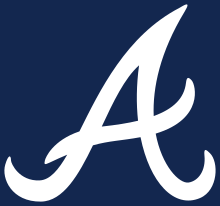
The Atlanta Braves are an American professional baseball team based in the Atlanta metropolitan area. The Braves compete in Major League Baseball (MLB) as a member club of the National League (NL) East Division. The club was founded in Boston, Massachusetts, in 1871 as the Boston Red Stockings. The Braves are one of two remaining National League charter franchises that debuted in 1876 and are the oldest continuously operating professional sports franchise in North America. The franchise was known by various names until it adopted the Boston Braves name in 1912.
After 81 seasons and one World Series title in Boston, the club moved to Milwaukee, Wisconsin, in 1953. With a roster of star players such as Hank Aaron, Eddie Mathews, and Warren Spahn, the Milwaukee Braves won the World Series in 1957. Despite the team's success, fan attendance declined. The club's owners moved the team to Atlanta, Georgia, in 1966. (Full article...)
Did you know (auto-generated) - load new batch

- ... that getting bitten by an eel led Sean Barber to become an umpire?
- ... that baseball player Dwight Smith recorded a demo rhythm and blues album during the 1993–94 offseason?
- ... that Rickey Henderson was the first American League baseball player to join the 20–50 club?
- ... that Park "Saebyeolbe" Jong-ryeol was the first esports player to throw a Major League Baseball opening pitch?
- ... that in 1915, Walter McCredie unsuccessfully challenged the baseball color line that prohibited non-white players?
- ... that before Sean Jackson won three Ivy League basketball championships, he won high school state championships in both baseball and basketball?
- ... that Cam Booser retired from baseball to work as a carpenter in 2017 and made it to Major League Baseball in 2024?
- ... that Salty Parker, who spent 60 years in organized baseball, described his lifelong love of the game as "a beautiful disease"?
Quotes
| There are surprisingly few real students of the game in baseball; partly because everybody, my eighty-three year old grandmother included, thinks they learned all there was to know about it at puberty. Baseball is very beguiling that way. |
 Featured lists - load new batch
Featured lists - load new batch
-
Image 1Lou Gehrig, the namesake of the award
The Lou Gehrig Memorial Award is given annually to a Major League Baseball (MLB) player who best exhibits the character and integrity of Lou Gehrig, both on the field and off it. The award was created by the Phi Delta Theta fraternity in honor of Gehrig, who was a member of the fraternity at Columbia University. It was first presented in 1955, fourteen years after Gehrig's death. The award's purpose is to recognize a player's exemplary contributions in "both his community and philanthropy." The bestowal of the award is overseen by the headquarters of the Phi Delta Theta in Oxford, Ohio, and the name of each winner is inscribed onto the Lou Gehrig Award plaque in the Baseball Hall of Fame in Cooperstown, New York. It is the only MLB award conferred by a fraternity.
Twenty-eight winners of the Lou Gehrig Memorial Award are members of the National Baseball Hall of Fame. The inaugural winner was Alvin Dark. Curt Schilling (1995) and Shane Victorino (2008) received the award for working with the ALS Association and raising money for amyotrophic lateral sclerosis (ALS). The disease took Gehrig's life and is eponymously known as "Lou Gehrig's disease". Mike Timlin won the award in 2007 for his efforts in raising awareness and finding a cure for ALS, which took his mother's life in 2002. (Full article...) -
Image 2
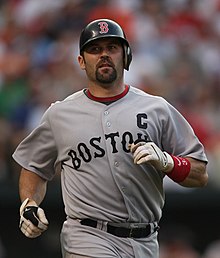
An All-American team is an honorary sports team composed of the best amateur players of a specific season for each position—who in turn are given the honorific "All-America" and typically referred to as "All-American athletes", or simply "All-Americans". Although the honorees generally do not compete as a unit, the term is used in U.S. team sports to refer to players who are selected by members of the national media. Walter Camp selected the first All-America team in the early days of American football in 1889. In 1950, the American Baseball Coaches Association (ABCA) selected its first All-American baseball team. It has since chosen All-American teams and a player of the year for each division (National Collegiate Athletic Association (NCAA) Division I, Division II, Division III, National Association of Intercollegiate Athletics, junior college, and high school). Collegiate Baseball selects All-American, Freshman All-American, and High School All-American teams. Baseball America magazine selects pre-season and post-season All-American teams and College Player of the Year honorees.
Various organizations selected All-American lists of the best players for the 1994 NCAA Division I college baseball season. The ABCA, the magazine Baseball America, and Collegiate Baseball were the NCAA-sanctioned selectors. This list only includes players selected to the post-season All-American first team for each selector. However, many All-American selections choose second, third, etc. teams from the remaining eligible candidates. (Full article...) -
Image 3

In baseball, a strikeout occurs when a pitcher throws three strikes to a batter during his time at bat. Twenty different pitchers have struck out at least 18 batters in a single nine-inning Major League Baseball (MLB) game, the most recent being Max Scherzer of the Washington Nationals on May 11, 2016. Four players have accomplished the feat more than once in their career; no player has ever struck out more than 20 batters in a nine-inning game. Charlie Sweeney was the first player to strike out 18 batters in a single game, doing so for the Providence Grays against the Boston Beaneaters on June 7, 1884. In spite of this, Bob Feller is viewed as the first pitcher to accomplish the feat, since his then-record 18 strikeouts was the first to occur during the 20th century and the live-ball era.
Out of the twenty pitchers who have accomplished the feat, fifteen were right-handed and five pitched left-handed. Five of these players have played for only one major league team. Six pitchers—Steve Carlton, Roger Clemens, Randy Johnson, Nolan Ryan, Tom Seaver, and Max Scherzer—are also members of the 3,000 strikeout club. Sweeney has the fewest career strikeouts in the group with 505, while Nolan Ryan, with 5,714, struck out more batters than any other pitcher in major league history. Bill Gullickson and Kerry Wood are the only rookies to have achieved the feat. Tom Seaver concluded his milestone game by striking out the final ten batters he faced, setting a new major league record for most consecutive strikeouts. (Full article...) -
Image 4
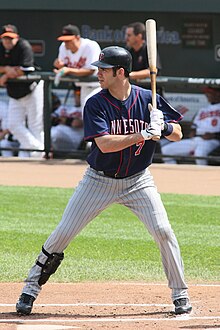
Joe Mauer, the Twins' first-overall selection in the 2001 draft, won an MVP, two Gold Gloves, three Silver Sluggers, and three batting titles.
The Minnesota Twins are a Major League Baseball (MLB) franchise based in Minneapolis, Minnesota. They play in the American League Central division. Since the institution of MLB's Rule 4 Draft, the Twins have selected 70 players in the first round. Officially known as the "First-Year Player Draft", the Rule 4 Draft is MLB's primary mechanism for assigning players from high schools, colleges, and other amateur clubs to its franchises. The draft order is determined based on the previous season's standings, with the team possessing the worst record receiving the first pick. In addition, teams which lost free agents in the previous off-season may be awarded compensatory or supplementary picks.
Of the 70 players picked in the first round by Minnesota, 30 have been pitchers, the most of any position; 22 of these were right-handed, while 8 were left-handed. Twelve outfielders were selected, while twelve shortstops, seven third basemen, four catchers, four first basemen and one player at second base were taken as well. Thirteen of the players came from high schools or universities in the state of California, and Florida follows with nine players. The Twins have drafted six players from Arizona, including five players from Arizona State University. (Full article...) -
Image 5

Joe Quinn, the first Australian to play in MLB
The first recorded baseball event in Australia took place in Melbourne, Victoria in 1857, between teams from Collingwood and Richmond. Accounts vary as to the details, including whether it was a single game or a series of three games, though details in common include a score of 350–230 in favour of Collingwood, and that the rules used were some form of hybrid between cricket and baseball, with teams batting until all players were out, and runs being scored for every base crossed, rather than just for reaching home plate. Though there are no records to confirm it, the commonly held belief is that baseball in Australia originated on the Ballarat gold-fields among American miners. The Claxton Shield, the first annually recurring national tournament, commenced in 1934. Though the tournament itself has been supplanted at various points in its history, the physical Shield is still awarded to the national champions in the Australian Baseball League.
As of the 2024 Major League Baseball (MLB) season[update], 38 Australians have played in at least one MLB game. Of those players, 33 were born in Australia, the remainder having been born elsewhere but raised in Australia and have played for the Australia national baseball team at International Baseball Federation or sanctioned tournaments such as the Olympic Games and World Baseball Classic. 25 of the players have been pitchers and the other 13 have been position players. (Full article...) -
Image 6

In Major League Baseball (MLB), the 20–20–20 club is the group of batters who have collected 20 doubles, 20 triples and 20 home runs in a single season. Frank Schulte was the first to achieve this, doing so in 1911. The last players to reach the milestone – Curtis Granderson and Jimmy Rollins – attained 20–20–20 during the 2007 season. This marked the first time that two players accomplished the achievement in the same season.
In total, seven players are members of the 20–20–20 club. Of these, five were left-handed batters, one was right-handed and one was a switch hitter, meaning he could bat from either side of the plate. Two players – George Brett and Willie Mays – are also members of the 3,000 hit club, and Mays is also a member of the 500 home run club. Schulte, Rollins, and Jim Bottomley won the Most Valuable Player (MVP) Award in the same year as their 20–20–20 season. Both Mays and Rollins joined the club while also hitting 30 home runs and stealing 30 bases that same season to join the 30–30 club. Brett and Rollins collected more than 200 hits alongside achieving 20–20–20. Furthermore, four players amassed 20 or more stolen bases during their 20–20–20 season. These players are collectively referred to as the 20–20–20–20 club. (Full article...) -
Image 7

Reggie Jackson (1966) won three World Series titles with the A's and was elected to the Baseball Hall of Fame in 1993.
The Athletics (the A's) are a Major League Baseball (MLB) franchise based in West Sacramento, California. They play in the American League West division. The Athletics had previously played in Philadelphia from 1901 to 1954, Kansas City from 1955 to 1967, and Oakland, California from 1968 to 2024. Since the establishment of the Rule 4 Draft the Athletics have selected 82 players in the first round. Officially known as the "First-Year Player Draft", the Rule 4 Draft is MLB's primary mechanism for assigning players from high schools, colleges, and other amateur clubs to its franchises. The draft order is determined based on the previous season's standings, with the team possessing the worst record receiving the first pick. In addition, teams which lost free agents in the previous off-season may be awarded compensatory or supplementary picks.
Of these 82 players, 36 have been pitchers, the most of any position; 27 of these were right-handed, while 9 were left-handed. Fifteen outfielders, including one center fielder, and 14 shortstops were selected. The A's have also drafted seven catchers, five third basemen, four first basemen, and one second baseman in the first round. Additionally, 23 players came from high schools or universities in the A's home state of California, followed by 10 from Texas and Florida. They also drafted Ariel Prieto in 1995, who had defected from Cuba the year before. Prieto made his major league debut in 1995, one of 20 players in draft history to go directly to the majors without playing in the minor leagues. (Full article...) -
Image 8

Jewish players have played in Major League Baseball since the league came into existence in the late 19th century, and have a long and storied history within the game. There have been 190 players who identified as Jewish during their Major League career, including players who converted during or before their careers, and players who have or had at least one Jewish parent, and identified as Jewish by virtue of their parentage.
In the early years, Jewish baseball players faced constant antisemitic heckles from opponents and fans, with many hiding their heritage to avoid discrimination in the league. Despite this, a number of Jewish players overcame such abuse and went on to become stars. Two such players, Hank Greenberg and Sandy Koufax, were both elected to the Baseball Hall of Fame and are widely considered to be amongst the most important and iconic players in baseball and American history. The sport played a large part in the assimilation of American Jews into American society at a time of rampant antisemitism, and remains a very important part in Jewish American culture today. (Full article...) -
Image 9

Yankee Stadium, New York's home field from 1923 to 1973, and 1976 to 2008.
The New York Yankees are a Major League Baseball (MLB) franchise based in The Bronx, New York City, New York. They play in the American League East division. The first game of the new baseball season for a team is played on Opening Day, and being named the Opening Day starter is an honor, which is often given to the player who is expected to lead the pitching staff that season, though there are various strategic reasons why a team's best pitcher might not start on Opening Day. The Yankees have used 58 different Opening Day starting pitchers in their 110 seasons. Since the franchise's beginning in 1901, the 58 starters have a combined Opening Day record of 58 wins, 36 losses, 1 tie (57–36–1), and 18 no decisions. No decisions are only awarded to the starting pitcher if the game is won or lost after the starting pitcher has left the game. Although in modern baseball, ties are rare due to extra innings, in 1910, New York's Opening Game against the Boston Red Sox was declared a tie due to darkness – at the time, Hilltop Park had lacked adequate lighting.
Whitey Ford, Ron Guidry, and Mel Stottlemyre hold the Yankees record for most Opening Day starts with seven. The other pitchers with three or more Opening Day starts for New York are CC Sabathia (6), Lefty Gomez (6), Red Ruffing (5), Jack Chesbro (4), Roger Clemens (4), Bob Shawkey (4), Masahiro Tanaka (4), Ray Caldwell (3), Jimmy Key (3), Vic Raschi (3), and most recently Gerrit Cole (3). Jimmy Key holds the Yankee record for best Opening Day record with a perfect 3–0. (Full article...) -
Image 10

David Ortiz has won the most Silver Slugger Awards as a designated hitter, with seven.
The Silver Slugger Award is awarded annually to the best offensive player at each position in both the American League (AL) and the National League (NL), as determined by the coaches and managers of Major League Baseball (MLB). These voters consider several offensive categories in selecting the winners, including batting average, slugging percentage, and on-base percentage, in addition to "coaches' and managers' general impressions of a player's overall offensive value". Managers and coaches are not permitted to vote for players on their own team. The Silver Slugger was first awarded in 1980 and is given by Hillerich & Bradsby, the manufacturer of Louisville Slugger bats. The award is a bat-shaped trophy, 3 feet (91 cm) tall, engraved with the names of each of the winners from the league and plated with sterling silver.
From 1980 to 2019, and in 2021, a Silver Slugger Award for designated hitters (DH) was only given in the American League, because use of a DH in place of the pitcher in the batting order was prohibited in the National League; a Silver Slugger Award for pitchers was given for the National League instead. In the 2020 season, the National League temporarily allowed use of the designated hitter, and no pitcher was awarded the Silver Slugger Award. An award was given instead to the best designated hitter in the National League. The first NL Silver Slugger Award for designated hitter was given to Marcell Ozuna. Beginning in 2022, the pitcher Silver Slugger Award was retired after MLB announced the full-time implementation of the universal DH rule in both leagues. The Silver Slugger Award for DH is now awarded in both leagues. (Full article...) -
Image 11

Bill Virdon is the all-time winningest manager in Astro history; he won 544 games while leading the Astros to their first postseason berth in 1980 and two division titles.
The Houston Astros are a professional baseball franchise based in Houston, Texas. They are a member of the American League West Division in Major League Baseball. The team joined MLB in 1962 as an expansion team named the Houston Colt .45s and changed their name to the Houston Astros in 1965. The team won their first NL Championship in 2005. Having first played in Colt Stadium (1962–1964), and later in The Astrodome, now known as the Reliant Astrodome (1965–1999), the Astros have played their home games at Minute Maid Park, which was first named The Ballpark at Union Station, since 2000. The current manager is Joe Espada.
There have been 25 managers for the Astros franchise. The team's first manager was Harry Craft, who managed for three seasons. Bill Virdon is the franchise's all-time leader for the most regular-season games managed (1066) and the most regular-season game wins (544). Dusty Baker is the franchise's all-time leader in career playoff games managed (53) and playoff games won (34). Salty Parker is the Astros' all-time leader for the highest regular-season winning percentage, as he has only managed one game, which he won. Of the managers who have managed a minimum of 162 games (one season), Baker has the highest regular-season winning percentage with .594. Leo Durocher is the only Astros manager to have been elected into the Baseball Hall of Fame. Durocher and Baker each achieved their 2,000th managerial win with the Astros. Garner, Hinch, and Baker are the only managers to have won league pennants with the franchise, Garner winning one in the National League in 2005, Hinch winning two in the American League in 2017 and 2019, and Baker winning two in 2021 and 2022. Larry Dierker is the only Astros manager to have had his uniform number retired by the Astros, with his uniform number 49 retired by the Astros in 2002. Dierker is also the sixth manager in MLB history to win a division championship in his first season for the Astros in 1997. Lanier and Dierker are the only managers to have won a Manager of the Year Award with the Astros, winning it in 1986 and 1998 respectively. Grady Hatton, Lanier, Dierker, and Cooper have spent their entire managing careers with the Astros. (Full article...) -
Image 12
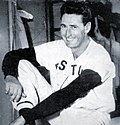
Ted Williams has the highest career on-base percentage in MLB history, led the American League in 12 seasons (also a record), and held the single-season on-base percentage record for 61 years.
In baseball statistics, on-base percentage (OBP) is a measure of how often a batter reaches base for any reason other than a fielding error, fielder's choice, dropped or uncaught third strike, fielder's obstruction, or catcher's interference. OBP is calculated in Major League Baseball (MLB) by dividing the sum of hits, walks, and times hit by a pitch by the sum of at-bats, walks, times hit by pitch and sacrifice flies. A hitter with a .400 on-base percentage is considered to be great and rare; only 61 players in MLB history with at least 3,000 career plate appearances (PA) have maintained such an OBP. Left fielder Ted Williams, who played 19 seasons for the Boston Red Sox, has the highest career on-base percentage, .4817, in MLB history. Williams led the American League (AL) in on-base percentage in twelve seasons, the most such seasons for any player in the major leagues. Barry Bonds led the National League (NL) in ten seasons, a NL record. Williams also posted the then-highest single-season on-base percentage of .5528 in 1941, a record that stood for 61 years until Bonds broke it with a .5817 OBP in 2002. Bonds broke his own record in 2004, setting the current single-season mark of .6094.
Players are eligible for the Hall of Fame if they have played at least 10 major league seasons, have been either retired for five seasons or deceased for six months, and have not been banned from MLB. These requirements leave 6 living players ineligible who have played in the past 5 seasons; 5 players (Bill Joyce, Ferris Fain, Jake Stenzel, Bill Lange, and George Selkirk) who did not play 10 seasons in MLB; and Shoeless Joe Jackson, who was banned for his role in the Black Sox Scandal.
Josh Gibson had a career obp of .458 but inexplicably isn’t on the list. (Full article...) -
Image 13

Roy Halladay is the only pitcher in Phillies history to throw multiple no-hit games with the team: a perfect game in May 2010; and a postseason no-hitter in October of that year.
The Philadelphia Phillies are a Major League Baseball franchise based in Philadelphia. They play in the National League East division. Also known in their early years as the "Philadelphia Quakers", pitchers for the Phillies have thrown fourteen separate no-hitters in franchise history. A no-hitter is officially recognized by Major League Baseball only "when a pitcher (or pitchers) allows no hits during the entire course of a game, which consists of at least nine innings", though one or more batters "may reach base via a walk, an error, a hit by pitch, a passed ball or wild pitch on strike three, or catcher's interference". No-hitters of less than nine complete innings were previously recognized by the league as official; however, several rule alterations in 1991 changed the rule to its current form.
Of the fourteen no-hitters pitched by Phillies players, three have been won by a score of 6–0, and three by a score of 1–0, more common than any other results. The largest margin of victory in a Phillies no-hitter was ten runs, in a 10–0 win by Chick Fraser. Charlie Ferguson's no-hitter, the first in franchise history, was a 1–0 victory, as were two of the more recent regular season no-hitters, thrown by Kevin Millwood in 2003 and Roy Halladay in 2010. Three pitchers to throw no-hitters for the Phillies have been left-handed: Johnny Lush (in 1906), Terry Mulholland (in 1990) and Cole Hamels (in 2015). The other nine pitchers were right-handed. Halladay is the only Phillies' pitcher to throw more than one no-hitter in a Phillies uniform, and others, including Hall of Famer Jim Bunning, have pitched more than one in their careers. The longest interval between Phillies no-hitters was between the games pitched by Lush and Bunning, encompassing 58 years, 1 month, and 20 days from May 1, 1906 to June 21, 1964. Conversely, the shortest interval between no-hitters was between Halladay's two 2010 no-hitters, with a total of merely four months and seven days from May 29 to October 6; the shortest gap between regular-season no-hitters was between Mulholland's and Tommy Greene's games (nine months and eight days from August 15, 1990 to May 23, 1991). Two opponents have been no-hit by the Phillies more than one time: the San Francisco Giants, who were defeated by Mulholland (in 1990) and Millwood (in 2003); and the Cincinnati Reds, who were no-hit by Rick Wise (in 1971) and Halladay (in 2010). (Full article...) -
Image 14The Chicago White Sox is a U.S. professional baseball team based in Chicago, Illinois. The White Sox are members of the American League Central Division in Major League Baseball. In baseball, the head coach of a team is called the manager, or more formally, the field manager. The duties of the team manager include team strategy and leadership on and off the field. Since the inception of the team in 1901, it has employed 41 different managers. The team's most recent manager was Pedro Grifol. Grifol was hired on November 3, 2022. Grifol was fired on August 8, 2024.
Grifol replaced Tony La Russa, who was re-hired on October 29, 2020. La Russa's first managerial stint with the team lasted from 1979 to 1986. (Full article...) -
Image 15
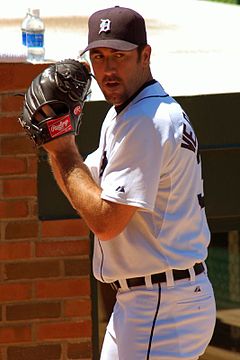
Justin Verlander (2004) is the only first-round pick of the Detroit Tigers to win the Rookie of the Year award.
The Detroit Tigers are a Major League Baseball (MLB) franchise based in Detroit, Michigan. They play in the American League Central division. Since the institution of MLB's Rule 4 Draft, the Tigers have selected 66 players in the first round. Officially known as the "First-Year Player Draft", the Rule 4 Draft is MLB's primary mechanism for assigning players from high schools, colleges, and other amateur clubs to its franchises. The draft order is determined based on the previous season's standings, with the team possessing the worst record receiving the first pick. In addition, teams which lost free agents in the previous off-season may be awarded compensatory or supplementary picks.
Of the 66 players picked in the first round by Detroit, 32 have been pitchers, the most of any position; 25 of these were right-handed, while five were left-handed. Thirteen outfielders were selected, while five shortstops, five catchers, four third basemen, three first basemen, and two second baseman were taken as well. One additional player, Lance Parrish (1974), was drafted as an infielder but ultimately spent the majority of his Major League career at catcher. Thirteen of the players came from high schools or universities in the state of California, followed by Texas with ten players. The Tigers have also drafted five players from their home state of Michigan. (Full article...)
More did you know
- ... that Negro league baseball executive Cum Posey organized the East-West League in 1932, but the league folded before the end of the season?
- ... that Freeman Fitzgerald played football with Knute Rockne and once struck out 19 batters in a baseball game?
- ... that despite being named one of the "top prospects of the decade" by Baseball America, American baseball pitcher Nick Neugebauer compiled a career record of just two wins and eight losses?
- ... that Milwaukee Brewers baseball player Dan Thomas was called the "Sundown Kid" because he refused to play on Sabbath?
- ... that when Roger Bresnahan adopted the use of shin guards in Major League Baseball on Opening Day in 1907, angry fans threw snow onto the field?
Sports portals
Selected picture
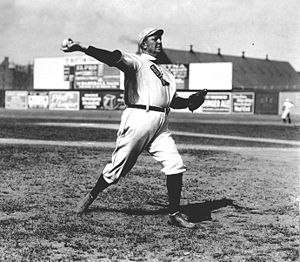
| Credit: George Grantham Bain |
Denton True "Cy" Young (March 29, 1867 – November 4, 1955) was an American baseball player who pitched for five different major league teams from 1890 to 1911. During his 22-year career, Young established numerous professional pitching records in the majors, some of which have stood for a century. Young retired with 511 career wins, 94 wins ahead of Walter Johnson, who is second on the list of most wins in Major League history. In honor of Young's contributions to Major League Baseball (MLB), the Cy Young Award, an annual award given to the pitcher voted the most effective in each of the two leagues, was created in 1956. Young was also elected to the Baseball Hall of Fame in 1937.
Associated Wikimedia
The following Wikimedia Foundation sister projects provide more on this subject:
-
Commons
Free media repository -
Wikibooks
Free textbooks and manuals -
Wikidata
Free knowledge base -
Wikinews
Free-content news -
Wikiquote
Collection of quotations -
Wikisource
Free-content library -
Wikiversity
Free learning tools -
Wiktionary
Dictionary and thesaurus
More portals
- Portals with triaged subpages from June 2018
- All portals with triaged subpages
- Portals with no named maintainer
- Automated article-slideshow portals with 51–100 articles in article list
- Automated article-slideshow portals with 501–1000 articles in article list
- Random portal component with 41–50 available subpages
- Automated article-slideshow portals with 201–500 articles in article list
- Random portal component with 11–15 available subpages
- Random portal component with 21–25 available image subpages

